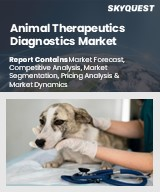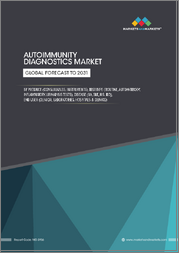
|
시장보고서
상품코드
1569490
면역진단 시장 규모, 점유율, 성장 분석 : 제품별, 용도별, 최종사용자별, 지역별 - 산업 예측(2024-2031년)Immunodiagnostics Market Size, Share, Growth Analysis, By Product (Instruments, Reagents & Consumables), By Application (Cardiac Markers, Infectious Diseases), By End user (Clinical Laboratories, Hospitals), By Region - Industry Forecast 2024-2031 |
||||||
세계의 면역진단 시장 규모는 2022년에 232억 달러로 평가되며, 2023년 241억 7,000만 달러에서 2031년에는 336억 달러에 달하며, 예측 기간 중(2024-2031년) CAGR로 4.20%의 성장이 예측됩니다.
세계의 면역진단 시장은 여러 가지 주요 요인으로 인해 높은 성장세를 보일 것으로 예상됩니다. 면역 진단은 다양한 질병의 진단 및 모니터링에 면역 기반 분석을 활용하고 있으며, 감염성 질환, 자가면역 질환 및 암 발병률 증가로 인해 정확하고 효율적인 진단 솔루션에 대한 수요가 크게 증가하고 있습니다. 효소 결합 면역 흡착 분석법(ELISA), 화학 발광 면역 분석법(CLIA), 신속 진단 검사 등 면역 분석의 기술 발전은 민감도와 특이성을 크게 향상시켜 시장 확대에 기여하고 있습니다. 또한 질병 조기 발견의 중요성에 대한 인식이 높아지고 맞춤형 의료의 인기가 높아지면서 면역 진단 툴에 대한 수요가 지속적으로 증가하고 있습니다. 그 결과, 미국 면역진단 시장은 향후 1년간 지속적인 CAGR을 유지할 것으로 예상됩니다. 이러한 추세는 건강 문제를 효과적으로 해결하고 환자 결과를 개선하기 위해 혁신적인 진단 방법에 대한 의존도가 높아지고 있음을 보여줍니다. 전반적으로, 기술 혁신과 인식 증가로 인해 면역 진단 분야는 헬스케어 전망에서 실질적인 진전을 이룰 수 있는 분야로 자리매김하고 있습니다.
목차
서론
- 조사의 목적
- 정의
- 시장 범위
조사 방법
- 정보 조달
- 2차 데이터 소스와 1차 데이터 소스
- 시장 규모 예측
- 시장의 상정과 제한
개요
- 시장 개요 전망
- 공급 수요 동향 분석
- 부문별 기회 분석
시장 역학과 전망
- 시장 역학
- 촉진요인
- 기회
- 억제요인
- 과제
- Porter의 산업 분석
주요 시장 인사이트
- 기술 분석
- 밸류체인 분석
- 시장의 에코시스템
- 사례 연구 분석
- 규제 상황
- 혁신 매트릭스
- 주요 투자 분석
- 주요 성공 요인
- 경쟁의 정도
면역진단 시장 : 제품별
- 시장 개요
- 기기
- 시약·소모품
면역진단 시장 : 용도별
- 시장 개요
- 종양·내분비
- 간염·레트로바이러스
- 심장 마커
- 감염증
- 기타
면역진단 시장 : 최종사용자별
- 시장 개요
- 임상 검사실
- 병원
- 의사 진료소
- 온라인 약국
면역진단 시장 규모 : 지역별
- 시장 개요
- 북미
- 미국
- 캐나다
- 유럽
- 독일
- 스페인
- 프랑스
- 영국
- 이탈리아
- 기타 유럽 지역
- 아시아태평양
- 중국
- 인도
- 일본
- 한국
- 기타 아시아태평양
- 라틴아메리카
- 브라질
- 기타 라틴아메리카 지역
- 중동 및 아프리카(MEA)
- GCC 국가
- 남아프리카공화국
- 기타 중동 및 아프리카 지역
경쟁 구도
- 상위 5사의 비교
- 주요 기업의 시장 포지셔닝(2023년)
- 주요 시장 기업이 채택한 전략
- 시장에서의 최근 활동
- 주요 기업의 시장 점유율(2023년)
주요 기업 개요
- Abbott(US)
- Roche Diagnostics(Switzerland)
- DiaSorin(Italy)
- Danaher Corporation(US)
- QIAGEN(Netherlands)
- bioMerieux(France)
- Thermo Fisher Scientific(US)
- Quest Diagnostics(US)
- Siemens Healthineers AG(Germany)
- Bio-Rad Laboratories, Inc.(US)
- Sysmex Corporation(Japan)
- PerkinElmer, Inc.(US)
- Agilent Technologies, Inc.(US)
- Mindray Medical International Limited(China)
- Grifols, S.A.(Spain)
- Becton, Dickinson and Company(BD)(US)
- Abcam plc(UK)
- Merck KGaA(Germany)
- Enzo Biochem, Inc.(US)
- Bio-Techne Corporation(US)
- Meso Scale Diagnostics, LLC.(US)
- GenScript Biotech Corporation(China)
- Myriad Genetics, Inc.(US)
Global Immunodiagnostics Market size was valued at USD 23.2 billion in 2022 and is poised to grow from USD 24.17 billion in 2023 to USD 33.6 billion by 2031, growing at a CAGR of 4.20% during the forecast period (2024-2031).
The global immunodiagnostics market is poised for robust growth, driven by multiple key factors. Immunodiagnostics involves employing immune-based assays to diagnose and monitor a wide array of diseases, and the increasing incidence of infectious diseases, autoimmune disorders, and cancer is significantly boosting the demand for precise and efficient diagnostic solutions. Technological advancements in immunoassay methodologies, including enzyme-linked immunosorbent assays (ELISA), chemiluminescence immunoassays (CLIA), and rapid diagnostic tests, have notably enhanced sensitivity and specificity, thereby contributing to market expansion. Furthermore, a growing awareness regarding the importance of early disease detection, coupled with the rising popularity of personalized medicine, continues to stimulate demand for immunodiagnostic tools. As a result, the U.S. immunodiagnostics market is anticipated to maintain a sustainable compound annual growth rate (CAGR) in the upcoming forecast year. This trend highlights the increasing reliance on innovative diagnostic methods to effectively address health challenges and improve patient outcomes. Overall, the convergence of technological innovations and heightened awareness positions the immunodiagnostics sector for substantial progression in the healthcare landscape.
Top-down and bottom-up approaches were used to estimate and validate the size of the global immunodiagnostics market and to estimate the size of various other dependent submarkets. The research methodology used to estimate the market size includes the following details: The key players in the market were identified through secondary research, and their market shares in the respective regions were determined through primary and secondary research. This entire procedure includes the study of the annual and financial reports of the top market players and extensive interviews for key insights from industry leaders such as CEOs, VPs, directors, and marketing executives. All percentage shares split, and breakdowns were determined using secondary sources and verified through Primary sources. All possible parameters that affect the markets covered in this research study have been accounted for, viewed in extensive detail, verified through primary research, and analyzed to get the final quantitative and qualitative data.
global immunodiagnostics Market Segmental Analysis
Global Immunodiagnostics Market is segmented by Product, Application, End user, and region. Based on Product, the market is segmented into Instruments, and Reagents & Consumables. Based on Application, the market is segmented into Oncology & Endocrinology, Hepatitis & Retrovirus, Cardiac Markers, Infectious Diseases, and Others. Based on End user, the market is segmented into Clinical Laboratories, Hospitals, Physician's Offices, and Others. Based on region, the market is segmented into North America, Europe, Asia Pacific, Latin America and Middle East & and Africa.
Driver of the global immunodiagnostics Market
The increasing emphasis on early disease detection is driving the global immunodiagnostics market, as healthcare providers recognize that timely intervention can significantly enhance treatment outcomes and lower overall healthcare expenses. Immunodiagnostics play a pivotal role by enabling the identification of specific biomarkers and molecular targets, which in turn supports early diagnosis and the development of personalized treatment strategies tailored to individual patient profiles. This shift towards precision medicine not only fosters more effective clinical decisions but also promotes patient-centered care, thereby propelling demand for immunodiagnostic solutions across various healthcare settings and ultimately reinforcing market growth.
Restraints in the global immunodiagnostics Market
One of the primary market restraints for the global immunodiagnostics market is the high cost associated with the acquisition and maintenance of diagnostic equipment and reagents. These financial burdens can hinder the adoption of immunodiagnostic tests, particularly in resource-limited settings where healthcare budgets are constrained. As hospitals and clinics in developing regions grapple with limited funding and competing healthcare priorities, the significant investment required for immunodiagnostic technologies may deter facilities from implementing these advanced diagnostic solutions. Consequently, this pricing challenge can impede the overall growth and accessibility of immunodiagnostics, ultimately affecting patient care and outcomes in underserved populations.
Market Trends of the global immunodiagnostics Market
In recent years, the global immunodiagnostics market has witnessed a significant trend towards the integration of digital health solutions driven by technological advancements and an increased demand for efficient healthcare delivery. This shift encompasses the adoption of online platforms for testing, mobile applications for result tracking, and telehealth services that facilitate remote consultations and monitoring. As patients and providers leverage wearables and remote diagnostic tools, the immunodiagnostics sector is increasingly characterized by real-time data sharing, streamlined workflows, and enhanced patient engagement. This trend is expected to bolster market growth, reflecting a larger movement towards personalized and accessible healthcare solutions.
Table of Contents
Introduction
- Objectives of the Study
- Definitions
- Market Scope
Research Methodology
- Information Procurement
- Secondary & Primary Data Sources
- Market Size Estimation
- Market Assumptions & Limitations
Executive Summary
- Market Overview Outlook
- Supply Demand Trend Analysis
- Segmental Opportunity Analysis
Market Dynamics & Outlook
- Market Dynamics
- Drivers
- Opportunities
- Restraints
- Challenges
- Porters Analysis
- Competitive rivalry
- Threat of Substitute Products
- Bargaining Power of Buyers
- Threat of New Entrants
- Bargaining Power of Suppliers
Key Market Insights
- Technology Analysis
- Value Chain Analysis
- Ecosystem of the Market
- Case study Analysis
- Regulatory Landscape
- Innovation Matrix
- Top Investment Analysis
- Key Success Factor
- Degree of Competition
Immunodiagnostics Market by Product
- Market Overview
- Instruments
- Reagents & Consumables
Immunodiagnostics Market by Application
- Market Overview
- Oncology & Endocrinology
- Hepatitis & Retrovirus
- Cardiac Markers
- Infectious Diseases
- Others
Immunodiagnostics Market by End user
- Market Overview
- Clinical Laboratories
- Hospitals
- Physician's Offices
- Online Pharmacies
Immunodiagnostics Market Size by Region
- Market Overview
- North America
- USA
- Canada
- Europe
- Germany
- Spain
- France
- UK
- Italy
- Rest of Europe
- Asia Pacific
- China
- India
- Japan
- South Korea
- Rest of Asia-Pacific
- Latin America
- Brazil
- Rest of Latin America
- Middle East & Africa (MEA)
- GCC Countries
- South Africa
- Rest of MEA
Competitive Landscape
- Top 5 Player Comparison
- Market Positioning of Key Players, 2023
- Strategies Adopted by Key Market Players
- Recent Activities in the Market
- Key Companies Market Share (%), 2023
Key Company Profiles
- Abbott (US)
- Company Overview
- Business Segment Overview
- Financial Updates
- Key Developments
- Roche Diagnostics (Switzerland)
- Company Overview
- Business Segment Overview
- Financial Updates
- Key Developments
- DiaSorin (Italy)
- Company Overview
- Business Segment Overview
- Financial Updates
- Key Developments
- Danaher Corporation (US)
- Company Overview
- Business Segment Overview
- Financial Updates
- Key Developments
- QIAGEN (Netherlands)
- Company Overview
- Business Segment Overview
- Financial Updates
- Key Developments
- bioMerieux (France)
- Company Overview
- Business Segment Overview
- Financial Updates
- Key Developments
- Thermo Fisher Scientific (US)
- Company Overview
- Business Segment Overview
- Financial Updates
- Key Developments
- Quest Diagnostics (US)
- Company Overview
- Business Segment Overview
- Financial Updates
- Key Developments
- Siemens Healthineers AG (Germany)
- Company Overview
- Business Segment Overview
- Financial Updates
- Key Developments
- Bio-Rad Laboratories, Inc. (US)
- Company Overview
- Business Segment Overview
- Financial Updates
- Key Developments
- Sysmex Corporation (Japan)
- Company Overview
- Business Segment Overview
- Financial Updates
- Key Developments
- PerkinElmer, Inc. (US)
- Company Overview
- Business Segment Overview
- Financial Updates
- Key Developments
- Agilent Technologies, Inc. (US)
- Company Overview
- Business Segment Overview
- Financial Updates
- Key Developments
- Mindray Medical International Limited (China)
- Company Overview
- Business Segment Overview
- Financial Updates
- Key Developments
- Grifols, S.A. (Spain)
- Company Overview
- Business Segment Overview
- Financial Updates
- Key Developments
- Becton, Dickinson and Company (BD) (US)
- Company Overview
- Business Segment Overview
- Financial Updates
- Key Developments
- Abcam plc (UK)
- Company Overview
- Business Segment Overview
- Financial Updates
- Key Developments
- Merck KGaA (Germany)
- Company Overview
- Business Segment Overview
- Financial Updates
- Key Developments
- Enzo Biochem, Inc. (US)
- Company Overview
- Business Segment Overview
- Financial Updates
- Key Developments
- Bio-Techne Corporation (US)
- Company Overview
- Business Segment Overview
- Financial Updates
- Key Developments
- Meso Scale Diagnostics, LLC. (US)
- Company Overview
- Business Segment Overview
- Financial Updates
- Key Developments
- GenScript Biotech Corporation (China)
- Company Overview
- Business Segment Overview
- Financial Updates
- Key Developments
- Myriad Genetics, Inc. (US)
- Company Overview
- Business Segment Overview
- Financial Updates
- Key Developments



















